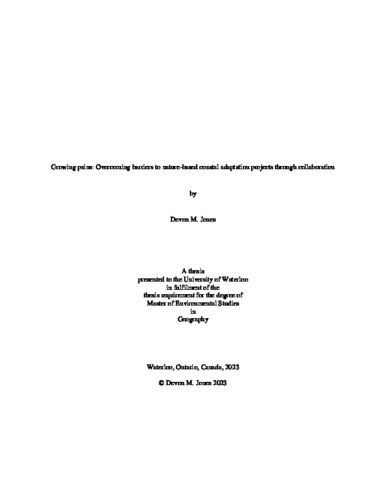| dc.contributor.author | Jones, Devon | |
| dc.date.accessioned | 2023-09-26 13:31:09 (GMT) | |
| dc.date.available | 2023-09-26 13:31:09 (GMT) | |
| dc.date.issued | 2023-09-26 | |
| dc.date.submitted | 2023-09-14 | |
| dc.identifier.uri | http://hdl.handle.net/10012/19947 | |
| dc.description.abstract | Coastal climate impacts have evolved so that the solutions that infrastructure managers have historically used to adapt to flooding may no longer be sufficient. Consequently, many have begun to consider alternatives to conventional grey infrastructure, including nature-based coastal adaptation (NBCA) projects. NBCA projects, a subset of nature-based solutions, have several characteristics that provide additional benefits compared to grey infrastructure, but those same characteristics and the novelty of the solutions can make NBCA challenging to implement. To overcome those challenges, collaboration has been suggested as a way of drawing on multiple perspectives, skillsets, and knowledge bases. To examine the ability of collaboration to advance NBCA projects, I conducted a case study of the Boundary Bay Living Dike (BBLD), one of the first NBCA projects in the Canadian province of British Columbia. I conducted interviews with 32 individuals who had been directly involved with the BBLD project to understand participants’ perspectives on 1) the barriers to BBLD, and 2) the ways in which collaboration interacted with those conditions. In examining the interview data and building on the barriers to adaptation literature, I developed a conceptualization of enabling conditions: factors that help or hinder a project based on the degree to which they are present, the timeframe over which they are available, the presence of actors who can make use of them, and the conditions’ interactions with each other. In doing so, I found that the most significant hindering factors were institutional (such as jurisdiction and mandate, assumptions and paradigm, and regulations) and systemic (influenced by conditions such as the Covid-19 pandemic and high inflation). I then examined the ways in which collaboration interacted with those conditions by applying a framework of action-based roles to characterize the collaborative process surrounding the BBLD, finding that collaborators were able to both support the project within formal structures and fill the gaps left by systems not designed to accommodate NBCA. These findings contribute conceptually to the barriers to adaptation literature, and practically to both those looking to implement NBCA and those with the ability to develop systems to enable them. | en |
| dc.language.iso | en | en |
| dc.publisher | University of Waterloo | en |
| dc.subject | Climate change adaptation | en |
| dc.subject | Collaboration | en |
| dc.subject | Nature-based coastal adaptation | en |
| dc.subject | Enabling conditions | en |
| dc.title | Growing pains: Overcoming barriers to nature-based coastal adaptation projects through collaboration | en |
| dc.type | Master Thesis | en |
| dc.pending | false | |
| uws-etd.degree.department | Geography and Environmental Management | en |
| uws-etd.degree.discipline | Geography | en |
| uws-etd.degree.grantor | University of Waterloo | en |
| uws-etd.degree | Master of Environmental Studies | en |
| uws-etd.embargo.terms | 0 | en |
| uws.contributor.advisor | Doberstein, Brent | |
| uws.contributor.advisor | Doyon, Andreanne | |
| uws.contributor.affiliation1 | Faculty of Environment | en |
| uws.published.city | Waterloo | en |
| uws.published.country | Canada | en |
| uws.published.province | Ontario | en |
| uws.typeOfResource | Text | en |
| uws.peerReviewStatus | Unreviewed | en |
| uws.scholarLevel | Graduate | en |

